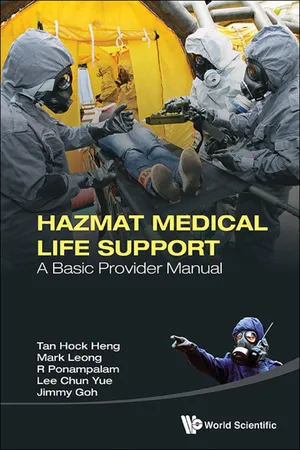
Hazmat Medical Life Support
A Basic Provider Manual
- 220 pages
- English
- ePUB (mobile friendly)
- Available on iOS & Android
Hazmat Medical Life Support
A Basic Provider Manual
About this book
The Hazmat medical life support basic provider course book aims to equip medical responders to a hazmat incident — chemical, radiological or biological — with essential skills and knowledge to safely manage casualties. It includes basic information about hazmat agents and provides easy to remember algorithmic approaches for the on-scene management of a hazmat event. Essential information on setting up medical operations, triaging and approach to hazmat event, personal protective equipment, decontamination, wound management, life support as well as paediatric-specific issues are discussed in this book.
Request Inspection Copy
Contents:
-
- Introduction and Objectives (Mark Leong & Tan Hock Heng)
- Historical Perspectives (Mark Leong & Tan Hock Heng)
- Part 1 — Chemical Hazmat:
- Basic Toxicological Principles (R Ponampalam & Sohil Pothiawala)
- Part 1a — Industrial Hazmat Agents:
- Introduction to Industrial Chemicals (R Ponampalam)
- Asphyxiants (Sohil Pothiawala & R Ponampalam)
- Irritant Gases (Kenneth Tan & R Ponampalam)
- Corrosives (R Ponampalam & Gregory Cham)
- Hydrocarbons (Sohil Pothiawala & R Ponampalam)
- Part 1b — Chemical Warfare Agents:
- Nerve Agents (Lee Chun Yue)
- Drug Therapy for Nerve Agent Poisoning (Kenneth Tan & Lee Chun Yue)
- Non-Nerve Gas Chemical Warfare Agents (Phua Dong Haur & Lee Chun Yue)
- Part 2 — Approach to Hazmat Casualties:
- Medical Response to Hazmat Incidents (Chan Kim Chai, Lim Ghee Hian & Mark Leong)
- General Approach and Triage (Jimmy Goh)
- Personal Protective Equipment (Tan Hock Heng & Adeline Ngo)
- Decontamination Procedures (Adeline Ngo & Tan Hock Heng)
- Management of Open Wounds in Hazmat Casualties (Goh Siang Hiong)
- Provision of Life Support for Hazmat Casualties (Goh Siang Hiong)
- Hazmat and the Paediatric Patient (Gene Ong & Ng Kee Chong)
- Part 3 — Radiological and Biological Hazmat:
- Radiation Emergency Management (Goh Siang Hiong & Steven Lim)
- Biological Agents and the Management of Bioterrorism (Suresh Pillai & Steven Lim)
Readership: Emergency first responders and receivers including nurses, paramedics, doctors as well as incident managers will find this book an essential tool when responding to a hazmat incident. It could be used by junior staff with no experience in hazmat response as the information provided is quite basic. On the other hand, those experienced in this field including hazmat event managers would find this book a useful resource not only for themselves but as a tool for training their staff.
Frequently asked questions
- Essential is ideal for learners and professionals who enjoy exploring a wide range of subjects. Access the Essential Library with 800,000+ trusted titles and best-sellers across business, personal growth, and the humanities. Includes unlimited reading time and Standard Read Aloud voice.
- Complete: Perfect for advanced learners and researchers needing full, unrestricted access. Unlock 1.4M+ books across hundreds of subjects, including academic and specialized titles. The Complete Plan also includes advanced features like Premium Read Aloud and Research Assistant.
Please note we cannot support devices running on iOS 13 and Android 7 or earlier. Learn more about using the app.
Information


|
Summary
1.Hazardous materials are used in greater quantity today, and pose a threat either in accidental or deliberate release.
2.Chemicals are identified by their CAS number and classified according to their hazard classes.
3.First responders and first receivers need to be prepared for hazardous material incidents.
4.The HMLS basic provider course is aimed at equipping first responders and receivers with a clinical approach to hazmat events.
|

Table of contents
- Cover
- HalfTitle Page
- Title Page
- Copyright Page
- Contents
- Contributors
- Foreword
- Preface
- Chapter 1 Introduction and Objectives
- Chapter 2 Historical Perspectives
- Part 1 Chemical Hazmat
- Part 2 Approach to Hazmat Casualties
- Part 3 Radiological and Biological Hazmat
- Answers
- Acronyms
- Colour Plates
- Index